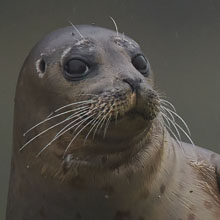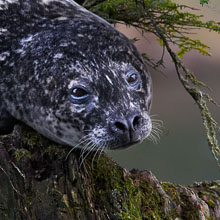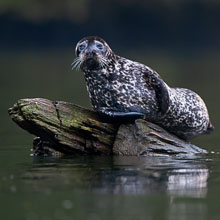Availability: Undetermined - Enquiries?
In the Field
Simply a Seal. Barkley Sound, SW coast of Vancouver Island, British Columbia, Canada. 5 April 2019.
The question I get asked most about the Nikkor 500mm f5.6E PF is "...but can you isolate the subject from the background as well as you can with the Nikkor 500mm f4E?" Inherent in this question is the thought that you need to use the f4 aperture of the 500mm f4E to get those "dreamy soft" backgrounds that make your sharp subject pop (and that the f5.6 aperture of the 500mm PF just isn't large enough to produce the same subject "pop"). Well...here's my multi-part answer:
1. The biggest single contributor to getting dreamy soft backgrounds with "tack sharp" subjects that pop out isn't the aperture you choose - it's the relative distance between you and the subject and the subject to its background. Simply put, you have to be closer to your subject than your subject is to the background. Yes, having a larger maximum aperture WILL give you a thinner DoF, but only if you can use that aperture and still get sharp shots.
2. The Nikkor 500mm f5.6E PF exhibits what I call Aperture Independent Sharpness (or AIS) - it is as sharp shot wide open as it is at virtually any aperture. The Nikkor 500mm f4E does NOT exhibit AIS - to get maximally sharp images with the 500mm f4E you have to stop the lens down by approximately 2/3 of a stop - which is f5. And that difference in sharpness between f4 and f5 IS noticeable without extreme pixel-peeping.
3. SO...while I will never argue that the 500mm f5.6E PF is JUST as good at separating subject from the background as the 500mm f4E is, it is really, really close - especially if you want your subject as sharp as possible (and thus stop down the 500mm f4 a little). There MAY be situations where ensuring the camera-to-subject-to-background distances necessary to get "dreamy soft" backgrounds are tougher to "create" with the 500 PF than with the 500mm f4, those situations are darned rare!
Bottom line for ME: The convenience of the small size, portability, and ease of hand-holding the 500 PF MORE than offsets the very slight (and, in my opinion, almost negligible) edge in subject isolation offered by the 500mm f4E. The only situation where I see a true "in the field" advantage to the 500mm f4E over the 500mm PF is if one regularly pairs the lenses with a TC-14EIII teleconverter - here the edge DOES go to the 500mm f4E (especially if one is shooting Nikon's DSLR bodies rather than mirrorless bodies).
This image? The 500mm PF paired with a D500...and shot wide open. While I can't PROVE this, I doubt it would have been any better (or the subject isolated any more effectively) if I shot it with a 500mm f4E!
Here's a considerably larger (2400 pixel) version of this simple seal:
• Simply a Seal: Download 2400 pixel image (JPEG: 0.7 MB)
ADDITIONAL NOTES:
1. This image was captured during our early spring "Pacific Rim Explorer" instructional photo tour in April of 2019. Each year we offer photo tours into several different parts of the Great Bear Rainforest as well trips to photograph marine mammals and oceanscapes in locations on Vancouver Island. And, in selected years, I also offer photo tours to locations to capture other highly sought-after subjects, such as Dall Sheep, Bald Eagles, and more. Details about these trips can be found on the Photo Tours page of this website.
2. This image - in all resolutions - is protected by copyright. I'm fine with personal uses of them (including use as desktop backgrounds or screensavers on your own computer), but unauthorized commercial use of the image is prohibited by law. Thanks in advance for respecting my copyright!
3. Like all wildlife photographs on this website, this image was captured following the strict ethical guidelines described in The Wildlife FIRST! Principles of Photographer Conduct. I encourage all wildlife photographers to always put the welfare of their subjects above the value of their photographs.
Behind the Camera
Simply a Seal. Barkley Sound, SW coast of Vancouver Island, British Columbia, Canada. 5 April 2019.
Digital Capture; Compressed RAW (NEF) 14-bit format; ISO 900.
Nikon D500 paired with Nikkor 500mm f5.6E PF telephoto lens (EFL of 750mm). Hand-held from floating Zodiac. VR on and in Sport mode. Single Point Area AF mode.
1/800s @ f5.6; -1.33 stop compensation from "recommended" matrix-metered exposure setting.
At the Computer
Simply a Seal. Barkley Sound, SW coast of Vancouver Island, British Columbia, Canada. 5 April 2019.
RAW Conversion to 16-bit PSD file (and JPEG files for web use), including all global and selective adjustments, using Phase One's Capture One Pro 12. Global adjustments to this shot were limited to noise reduction and highlight retrieval. Selective local adjustments performed using Capture One Pro's layers and masking tools. In this case adjustments were made on 6 separate layers and included one or more tweaks and/or local/selective edits to (or adjustment of) shadows, noise reduction, colour balance, and both sharpness and structure.
Photoshop modifications were limited to the insertion of the watermark and/or text.
Conservation
Simply a Seal. Barkley Sound, SW coast of Vancouver Island, British Columbia, Canada. 5 April 2019.
Species Status in Canada*: Most Harbour Seal populations in Canada are not listed as Threatened or Endangered. The Lac des Loups Marins landlocked population of Quebec (Ungave Peninsula) currently listed as Endangered (most recent assessment update - November 2007).
The Harbour Seal (Phoca vitulina) is found on both the eastern and western coasts of North America. They tend not to make long migrations and in many areas they are present year-round. When foraging Harbour Seals normally dive to between 30 and 100 metres in depth and stay below the surface for 5 to 6 minutes. On occasion they have been known to dive to depths of over 450 metres and have stay submerged for almost 30 minutes. Harbour Seals have a diverse diet, including cephalopod, crustacceans and a variety of fish such as herring, eulachon, pollock, and salmon.
Historically bounty programs were used in both Canada and the USA to reduce populations of Harbour Seals. In more recent times seals have become protected over much of North America and some populations have rebounded strongly (it is estimated that over 150,000 seals now occupy the coast of British Columbia). There is a land-locked and freshwater sub-species of the Harbour Seal found on the Ungava Peninsula of northern Quebec. This population is now down to an estimated 100 individuals and is listed as Endangered by COSEWIC.
*as determined by COSEWIC: The Committee on the Status of Endangered Wildlife in Canada.

























